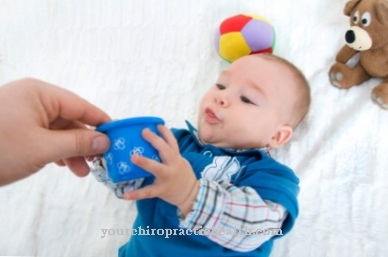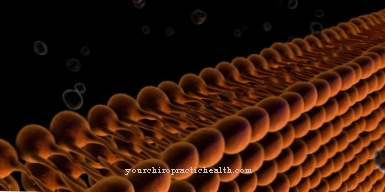In the medical field, the term includes Sensors the totality of the processes in sensory perception. Sensory perceptions include sight, hearing, taste, smell and the sense of balance.
What is the sensor system?

Sensory technology deals with the perception of stimuli in the sensory organs. The human sense organs include the eye, ear, nose and tongue.
The ear houses two sensory organs. On the one hand the vestibular organ, which is responsible for the sense of balance, and on the other hand the cochlea, the seat of the sense of hearing.
The skin also belongs to the classic sense organs. However, the sense of touch no longer counts in the field of sensor technology. It is assigned to the sensitive stimuli.
The entirety of the areas in the brain that are responsible for sensor technology are called sensory projection centers. All sensory organs including the nerve cells responsible for stimulus transmission and processing are also called the sensorium.
Function & task
The basic process of sensor technology is very similar in all sensory organs. The sense organ perceives a certain stimulus. This is then transmitted through various nerves either to the sensory brain area or to other structures of the central nervous system (CNS). The actual sensory impression is then produced there. One speaks here of the primary sensory impression.
In a second step, the primary impression is compared with data stored in the brain. This process is also known as sensory integration. Only when this integration of the sensory stimulus has taken place in the responsible brain centers, for example, objects can be recognized or writings read.
Only the sum of all sensory perceptions ultimately results in a perception or sensor system. One model of sensor technology is the so-called chain of perception. The starting point in the chain of perception is the stimulus. This is generated by an object. The stimulus can be in the form of sound or electromagnetic waves, for example. This stimulus then hits the corresponding sensory cell, for example the ear perceives sound. The cells in the corresponding sense organ absorb the stimulus, are excited by it and convert it. The converted stimulus is then transmitted to nerve cells.
Preprocessing of the stimulus often takes place in the sense organ itself. The main processing takes place in the sensory projection centers of the brain. Filters, inhibitions, convergences, divergences, integrations and so-called top-down processes take place in these areas of the brain.
Processing is followed by perception, which means that the stimulus becomes conscious here. For example, sound becomes sound or electromagnetic radiation becomes light. What is perceived is now remembered, combined, recognized, assigned or assessed in the brain. These processes are based on previous experience.
Recognition is the basis for a reaction to the perceived stimulus. It is controversial whether action really still belongs to sensor technology. At least the action has an influence on the next run through the chain of perception. Finally, the reaction to the stimulus is saved as an experience and in turn influences the processing of subsequent stimuli.
Visual perception is used by humans to perceive visual stimuli such as colors, lines, shapes and movements. The eye is responsible for visual perception. The auditory or acoustic sensor system takes place in the ear, more precisely in the cochlea, i.e. the bony cochlea of the ear. The auditory sensors enable the perception of tones, noises and sounds. Another part of the ear is responsible for vestibular perception, i.e. the sense of balance. Fragrances and fragrances are perceived through the olfactory sensory system. Here there is often a particularly strong processing in the sensory centers, since many emotions are associated with smells. The gustatory perception serves to absorb taste qualities. The associated sense organ is the tongue with the taste buds.
You can find your medication here
➔ Medicines for eye infectionsIllnesses & ailments
Faults in the sensory system can arise in the sense organs themselves as well as in the processing brain centers or in the nerve pathways that lead to them. One speaks of perceptual disorders when the processing of sensory impressions in the central nervous system is disturbed.
Tactile, kinesthetic, visual, auditory and vestibular perception disorders are differentiated according to the individual senses. Auditory perception disorders manifest themselves, for example, in the fact that those affected have difficulty filtering out background noises or cannot distinguish similar sounding sounds or syllables.
Visual disturbances in perception can show up as double vision, slow and stumbling reading, clumsiness or simply by burning and redness of the eyes.
With vestibular sensory disorders, the sense of balance is disturbed. The affected people find it difficult to keep their balance, sway when walking and find it difficult to orientate themselves in the room. Children with a vestibular perception disorder may stand out because they are extremely reluctant to rock.
The perception disorders only rarely affect one area of the sensory system. Usually there is a combined disorder. There are many causes for sensor malfunctions. The disorders can arise from congenital defects, as a result of developmental disorders or due to deficits in hearing or sight.
Of course, the sensory system is also disturbed if there is an impairment in the sense organs themselves. In the eye, nearsightedness or farsightedness or diseases such as cataracts or retinal detachment affect the sensor system. Diseases of the inner ear such as Menière's disease have an impact on vestibular sensors. Inflammation in the middle ear such as otitis media can affect the hearing process. A simple rhinitis, i.e. a cold, is enough to negatively influence the smelling process. A complete loss of the olfactory sensory system, i.e. the perception of smell, is called anosmia. A disturbance of the olfactory perception also has a direct effect on the taste perception.












.jpg)



.jpg)










.jpg)
